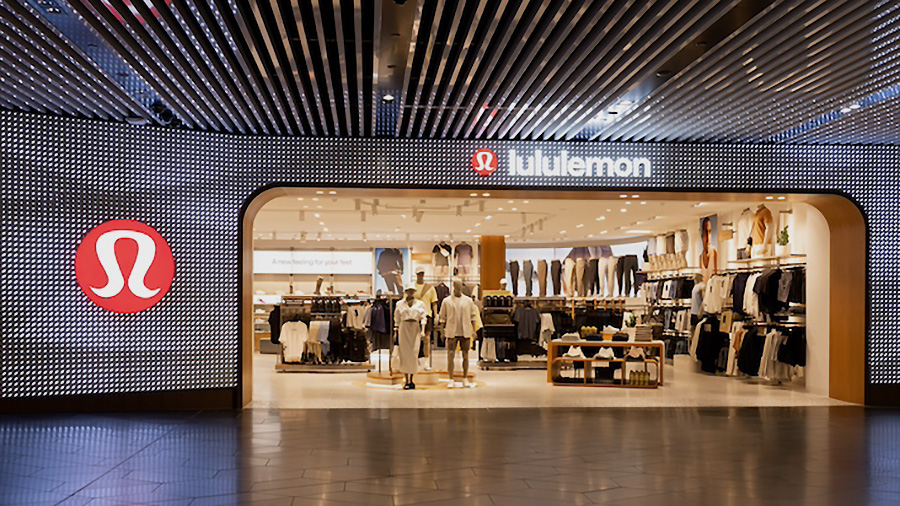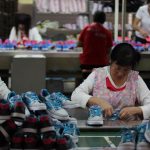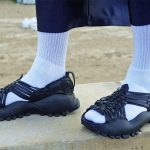Shares of Lululemon Athletica, Inc. were down about 20 percent in mid-day trading on Friday, June 6, after the yoga-themed retailer trimmed its earnings guidance for the year as proposed tariffs threaten the company’s supply chain. The maker of yoga wear and other athletic apparel now expects earnings of $14.58 to $14.78 a share for the fiscal year, down from its prior outlook of $14.95 to $15.15. The company continues to expect sales of $11.15 billion to $11.3 billion.
On an analyst call, Lululemon officials noted that they expect to offset the tariff costs through several mitigation efforts, including “modest” price increases on select items, supply chain efficiency actions and targeted sourcing shifts; however, the company expects the mitigation benefits mainly in the second half of the year, and LULU provided second-quarter guidance that was below analyst targets.
For the second quarter, the company expects earnings per share (EPS) to range from $2.85 to $2.90, with sales between $2.54 billion and $2.56 billion. Analysts, on average, were expecting EPS of $3.32 a share on sales of $2.57 billion.
The earnings pressure, to a lesser degree, reflects a more cautious consumer. Lululemon’s margin guidance for the year includes expectations for slightly higher markdowns.
On the call, company CFO Meghan Frank said, “Given consumer confidence and macroeconomics as we move into the second half of the year, we feel it’s prudent to tick up our forecast slightly on the markdown line.”
Gross margins for the year are now expected to be down approximately 110 basis points, compared to 2024 prior guidance for a 60-basis-point decrease. The change reflects an additional 50-basis point of deleverage to be driven predominantly by increased tariffs and slightly higher markdowns.
Lululemon officials remained bullish during the analyst call, discussing Lululemon’s position in the marketplace and its ability to overcome any disruptions caused by tariffs. Calvin McDonald, Lululemon’s CEO, said, “I feel we are well-positioned to navigate the current period. We intend to leverage our strong financial position and competitive advantages to play offense while making deliberate decisions and continuing to invest in our growth opportunities.”
First-Quarter Results Top Expectations
The lower outlook arrives as Lululemon reported earnings and sales exceeded guidance in the fiscal first quarter ended May 4, supported by double-digit growth in China, improving trends in the U.S. and a strong response to several new launches.
During the quarter, revenue increased 7.3 percent to $2.4 billion, or 8 percent on a constant-dollar basis. Revenues topped Lululemon’s guidance in the range of $2.33 billion to $2.35 billion.
In its store channel, sales increased 8 percent, driven by the addition of 59 net new stores since Q1 2024. It ended the quarter with 770 stores globally, with square footage expanding by 14 percent compared to last year. Digital sales increased 6 percent and accounted for 41 percent of revenue.
Gross margins increased 60 basis points to 58.3 percent, ahead of guidance. The improvement reflects a 130-basis-point increase in product margin, driven predominantly by lower product costs, improved damages and improved markdowns, offset somewhat by higher airfreight costs. These factors offset a 20-basis-point negative impact from foreign exchange and 50-basis-points of net deleverage on fixed costs.
SG&A expense increased to 39.8 percent of sales from 38.1 percent, reflecting investments to support growth, although the rate was above guidance due to an FX revaluation loss.
Operating income inched up 1.4 percent to $438.6 million while operating margin decreased 110 basis points to 18.5 percent.
Net earnings declined 2.1 percent to $314.6 million from $321.4 million from the prior year but improved on a per-share basis to $2.60 from $2.54 the prior year, with the benefit of stock buybacks reducing shares outstanding. EPS surpassed Lululemon’s guidance, which was in the range of $2.53 to $2.58.
Regional Performance
By region, Americas’ revenue increased 3 percent, or 4 percent on a constant-dollar basis. Americas’ comps decreased 2 percent, or 1 percent on a constant-dollar basis.
McDonald said momentum continued in Canada, where sales grew 9 percent in constant currency. He also noted that the U.S. revenue gain of 2 percent marked an improvement over the trend the company has seen over the last several quarters. McDonald said of the U.S. performance, “We’re making progress on our assortment, and we’ve seen good response to many of our new innovations. But, my sense is that in the U.S., consumers remain cautious right now and are being very intentional about their buying decisions. Even with this, we gained market share across both men’s and women’s in the premium athletic wear market in the United States.”
International net revenue increased 19 percent, or 20 percent on a constant-dollar basis. International comparable sales increased 6 percent, or 7 percent on a constant-dollar basis.
In China, revenue increased 22 percent in constant currency. The shift of the Chinese New Year to the fourth quarter this year from the first quarter the prior year was estimated to have had a negative impact of about four percentage points on China’s Q1 revenue growth. McDonald said, “We remain pleased with the underlying momentum in this very important growth market.”
In the Rest of World (ROW) segment, revenue increased 17 percent in constant currency with strength across APAC and EMEA regions. Call-outs included a “strong start“ to recent store openings in two franchise markets, Denmark and Turkey. McDonald said Lululemon remains on track to enter Italy as a new company-operated market, with Belgium and the Czech Republic under franchise models later this year.
For the full year, the company made no changes in expectations across regions. Revenue in North America remains projected to increase in the low- to mid-single-digit range.
On its fourth-quarter analyst call, Lululemon forecasted “modest growth” for the U.S. for 2025. China Mainland is still expected to grow in the 25 percent to 30 percent range, and revenue in the ROW segment to increase roughly 20 percent. Overall, Lululemon continues to expect 7 percent to 8 percent growth with no change in its expectations across regional segments.
Product Performance
By category, Men’s revenue increased 8 percent in the quarter versus last year, while Women’s advanced 7 percent and Accessories & Other grew 8 percent.
McDonald said that within Women’s, the Define franchise continues to perform well across markets, and recent launches have been well received, including Daydrift, Shake It Out, and BeCalm. For men, the company sees strength in several franchises, including Zeroed In, Smooth Spacer, and Show Zero. With the 10th anniversary of the Align franchise in May, Lululemon launched Align No Line, which removes the front seam from its popular legging range. Said McDonald, “We’re pleased with the guest response both online and in the 80 doors where it was offered. We plan to build on this momentum for the fall when we roll it to all stores.”
McDonald said that following the changes Lululemon made to its product organization about a year ago, the company has gained efficiencies in the product development process. “We still have work to do to create new products that have the potential to grow into core franchises and further optimize our merchandise mix. However, we are moving in the right direction,” said McDonald.
McDonald still sees a “significant opportunity“ for Lululemon to expand all five of its key activities: yoga, run, train, golf, and tennis. He said, “Recent examples include our new Fast and Free running short for men, and for women, we launched additional styles which leveraged the research and development our teams conducted last year for our Further ultra-marathon event.”
Brand Activations
McDonald also highlighted how Lululemon continues to benefit from brand campaigns and community events to drive engagement and support product launches. He noted that to celebrate Align’s anniversary, the company launched its Summer of Align campaign, which included traditional and social media, exclusive experiences and events and featured several influencers and LULU ambassadors. The company hosted worldwide events, including a Lululemon roller rink activation at the Bottle Rock Festival in Napa Valley, CA and the brand’s largest yoga experience in China, attended by 5,000 consumers in Beijing.
“This campaign and the other events we activated in quarter one is a great example of how we remain focused on our grassroots approach to guest engagement while at the same time leveraging traditional media assets and our roster of ambassadors to support product launches and build our brand,“ said McDonald. “In fact, our unaided brand awareness in the United States grew from the mid-30s in quarter four to 40 percent in quarter one.”
Tariff-Mitigation Strategies
To offset the impact of tariffs, Lululemon is exploring ways to reduce expenses, identifying efficiencies within its supply chain and considering price increases.
“During COVID, we developed a strong muscle across our teams to be agile, pull levers across the business within a rapidly changing external environment, and simultaneously plan for multiple scenarios,“ said McDonald. “We are applying the same approach now as we maintain a disciplined focus on expenses, look across our supply chain, leverage our dual sourcing capabilities, engage in costing discussions with our vendors, and review pricing scenarios to ensure we sit where we want in the market, are pricing appropriately for the innovation in our assortment, and maximize any opportunity to gain market share.”
Frank said Lululemon is planning “modest“ price increases on select items. She said, “We are planning to take strategic price increases, looking item by item across our assortment as we typically do, and it will be price increases on a small portion of our assortment, and they will be modest in nature.”
McDonald said about pricing decisions, “We have always been and will continue to be very intentional with our pricing decisions. These actions will be targeted and will reflect the work we’ve done on style elasticity. We remain nimble in our approach and feel we are well positioned during this period with many levers to pull.”
McDonald added that he believes Lululemon is “better positioned than most to navigate the near term“ while being able to invest in growth platforms in the long term. He said, “We are operating from a position of strength. Our brand remains strong, our guest engagement is high, we offer a compelling value proposition, and we are a highly profitable business.”
He cited the benefits of Lululemon’s “industry-leading operating margin,“ its balance sheet carrying $1.3 billion in cash and no debt and the progress it has made in innovation. McDonald further noted that Lululemon’s premium positioning in the performance athletic apparel space “yields different elasticity for our products relative to fashion-oriented brands“ while noting that Lululemon will continue to benefit from the strong appeal of active and healthy lifestyles.
McDonald said, “While we recognize that quarter two has some pressures related to our planned business investments and additional expenses related to tariffs, we feel good about the full year and our ability to maintain our revenue guidance for 2025.”
Image courtesy Lululemon
















